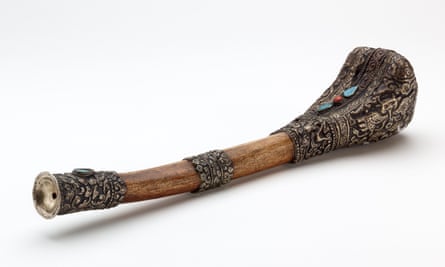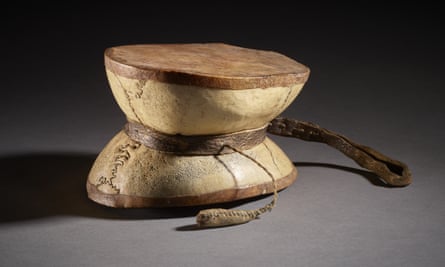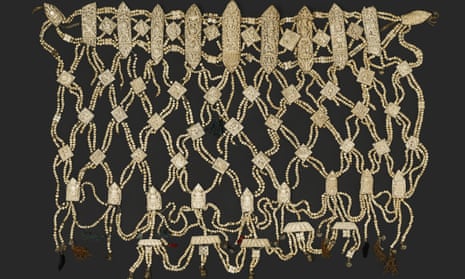Objects made from human remains, often labelled in the west as examples of witchcraft or necromancy, are to go on display for the first time at the British Museum with the hope they will finally be seen in their true light.
The museum is to display Tibetan objects, which include a drum made from the tops of two skulls; a trumpet made from a hollowed out thighbone; a ritual cup made from a skull and an apron of intricately carved human bone.
To British colonial officials and missionaries in the 19th and early 20th centuries, such items were morbid examples of devil worship. To Tibetans they were objects used to celebrate life.

Imma Ramos, the curator of the museum’s forthcoming exhibition on Tantra, hopes that by displaying such sensitive objects it will demystify them.
The objects shine light on how, in Tantric Buddhist practice, life is conceived as a preparation for death. “There is nothing nihilistic about that,” said Ramos. “It is very much celebrating life. It is a much more positive, holistic attitude to death which is very different to the west where there is a very negative mindset around mortality.”
The museum has held a number of consultations and workshops with Tibetans to prepare for the display and the exhibition will include audio interviews.
Thupten Kelsang, an Oxford student who has helped gather people for the workshops and consultations, welcomed the display. “These are esoteric objects, very specialised objects and can sometimes be taken out of context.
“I’m happy that with this exhibition Tibetans are finally coming forward and talking and sharing their opinions and life histories and experiences.”
The five objects from the museum’s collection, all going on public display for the first time include a two-headed drum (damaru) and a thigh trumpet (kangling) used in the practice of Chöd (cutting off), which was developed and popularised by an 11th-century female tantric practitioner Machig Labdrön. The instruments are used to invoke divine spirits to feast on your own body, which is a way of surrendering your ego.

A 19th-century skull cup (kapala) is going on display with its ornate metal base and cover. It would have been an important ritual object probably used in a communal Tantric practice performed by a group of lamas over several days.
Tibetan Tantric practitioners often willingly donated their skulls and bones to a lama and monasteries in order to gain spiritual merit after their death.
The bone apron (rus gyan) is an example of one worn by Tibetan monks and lamas during public festival and could have been used in dances with the purpose of generating merit to people watching and expel negative obstacles.
It was acquired by John Claude White, a civil servant in colonial India who was part of the British military invasion of Tibet in 1903-04.
He is likely to have seen the ritual as “devil-dancing”, language which is still often used by museums today, said Ayesha Fuentes, who is studying towards a PhD at Soas on the use of human remains in Tibetan Buddhist practice.
She hopes the Tantric exhibition will help change the way museums describe Tibetan human remains. “That language of devil worship and necromancy and sorcery …it originated from colonial scholarship and was disseminated all through the anglophone world. In the States, where I’m from, museum records everywhere will still bring up that language,” she said.

The subject of human remains in museum collections is often a charged one and continues to result in numerous repatriation cases. Arts Council England recently advertised for an expert to update its guidance on repatriation and restitution.
Museums have also been accused of being overly sensitive about displaying human remains, fearing a backlash that may not exist.
The British Museum has more than 6,000 examples of human remain, including Egyptian mummies and Lindow Man, who dates from the mid-first century and is considered the best preserved ancient body ever discovered in Britain.
The Tibetan human remains will be part of an exhibition exploring and exploding myths about Tantra, usually equated in the west with sex and yoga.
It is the UK’s first major exhibition about beliefs and rituals that began in sixth-century India. A major part of the show will be the importance of divine feminine power and challenging the perception of womanhood as passive and docile.
